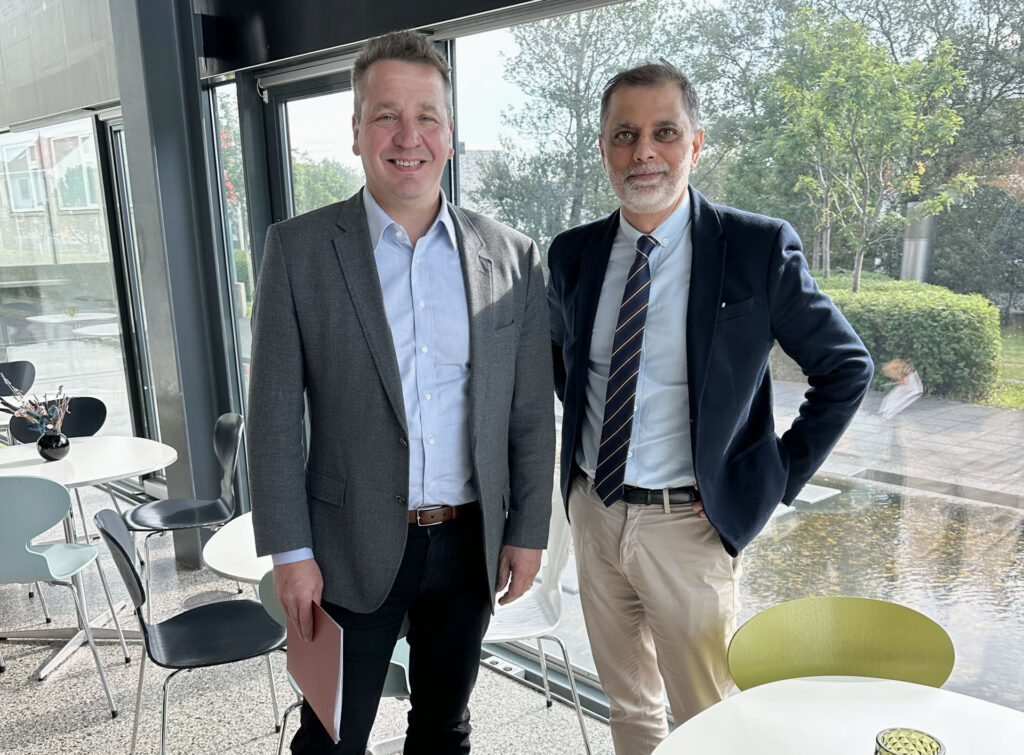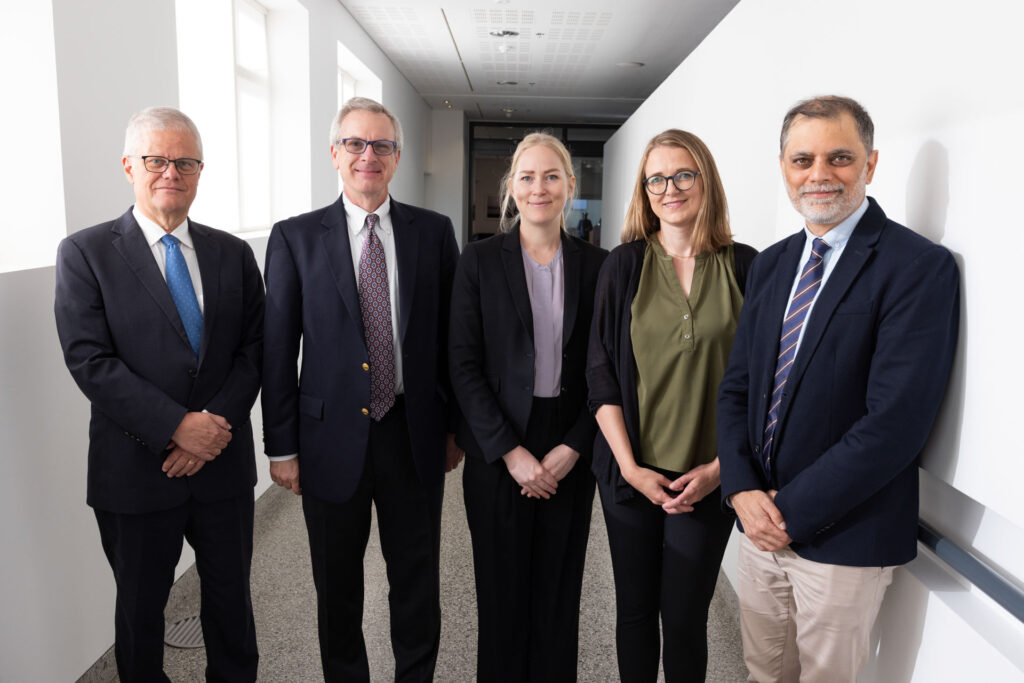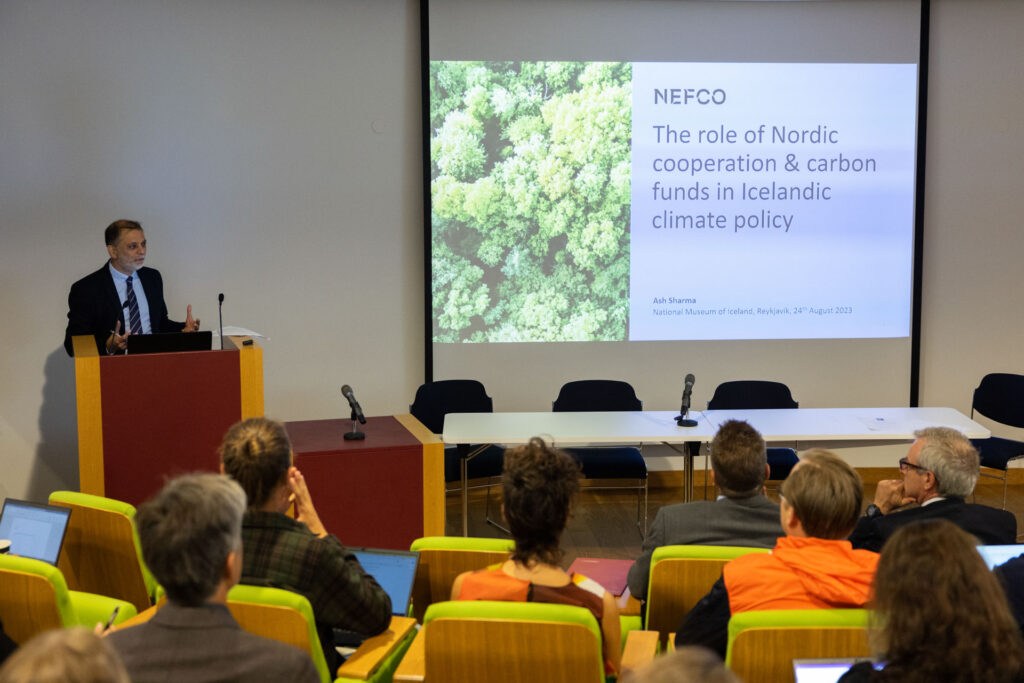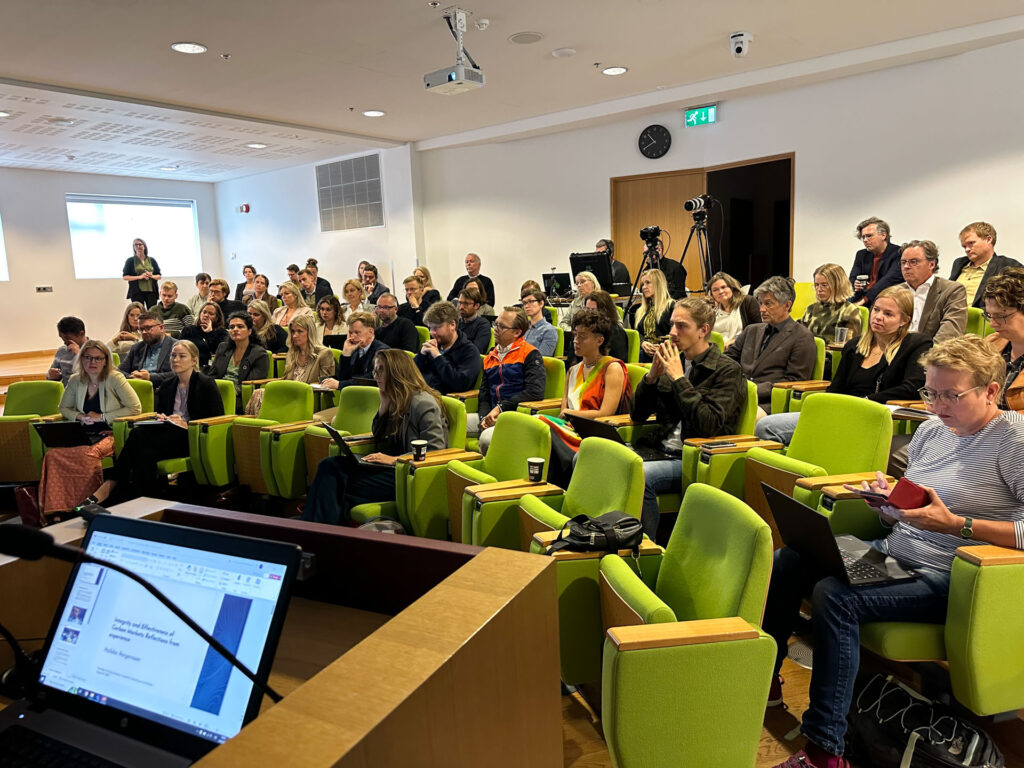12.09.2023 | Insight
What is the role of carbon markets in Iceland’s climate policy? Recent developments suggest potential interest in utilising voluntary carbon markets defined in the Paris Agreement Article 6.
Text by Hrafnhildur Bragadóttir, University of Iceland and Ash Sharma, Nefco
Nefco moderated a conference on the role of Carbon Market in Iceland’s Climate Policy, which took place in Reykjavik on 23 August 2023.
What are Iceland’s climate commitments and targets? What has been the Icelandic climate policy response and development of the country’s emissions? How are Icelandic companies reacting to the voluntary carbon market? Hrafnhildur Bragadóttir, University of Iceland and Ash Sharma, Nefco describe the proceedings of the conference and outline the implications for Icelandic climate policy.
Conference: The role of carbon market in Iceland’s climate policy
The main objective of the conference was to contribute to knowledge and capacity building on carbon markets in Iceland. The event followed a similar workshop on Paris Agreement Article 6 held in September 2022 that shared information about the use of carbon markets in other Nordic countries.
The conference, organised by the Law Institute of the University of Iceland in collaboration with the Institute for Sustainability Studies, brought together over 100 academics, policymakers, carbon market participants, and other national stakeholders, fostering productive discussions on the potential of carbon markets to accelerate climate action in both public and private sectors. A central theme was the role of law and public policy in facilitating the use of carbon markets to finance climate projects, while ensuring their integrity and contribution to global carbon neutrality.
The conference was opened by Guðlaugur Þór Þórðarson, Iceland’s Minister for the Environment, Energy and Climate who set out Iceland’s climate ambitions, outlining a supportive role for carbon markets and highlighting the need to build trust in order to have a well-functioning market.

The morning session, moderated by Ash Sharma, Vice President at Nefco, featured international speakers who gave an overview of the current trends and developments in international carbon markets, including the growing convergence between compliance and voluntary carbon markets. Sharma gave an introductory speech focusing on the role and lessons learnt from Nordic cooperation in two decades of carbon funds and the opportunity for Iceland to leverage this learning with like-minded governments.
Jonathan Wiener, Professor of Law, Environmental Policy, and Public Policy at Duke University (USA) provided a primer on carbon markets as climate policy tools and their current role (both compliance and voluntary markets) in global climate efforts.
Halldór Þorgeirsson, Chair of the Icelandic Climate Council and former Director for Strategy at the UNFCCC provided his reflections based on earlier experiences in particular lessons from the Clean Development Mechanism (CDM) and stressed the importance of safeguarding the integrity of the carbon markets and the need for national governance.
Cathrine Wenger, of Wenger Law practice (Norway) shared Norway’s experience in relation to the voluntary carbon market, corporate climate-related disclosure requirements and net-zero emission targets and gave an overview of legal, reputational and commercial risks.
Eve Tamme, Climate Principles (Netherlands/Estonia) focused on the link between Article 6 of the Paris Agreement and the voluntary carbon market and described the state of play in relation to carbon dioxide removals under both compliance and voluntary markets.
The afternoon session, conducted in Icelandic, was moderated by Dr. Aðalheiður Jóhannsdóttir, Professor of Law at the University of Iceland. It included presentations by Hrafnhildur Bragadóttir, adjunct lecturer and PhD student at the University of Iceland, who discussed the voluntary carbon market in the context of Icelandic climate law and policy, and Gunnar Sveinn Magnússon, Head of Sustainability at Deloitte Iceland, who addressed the role of carbon markets in corporate climate policies and measures. This session also included panel discussions featuring several domestic experts and stakeholders.
The conference was followed by a site visit to Carbfix mineralisation plant in Hellisheiði. Carbfix is an Icelandic company that has developed a method for capturing CO₂ and injecting it in liquified form into subsurface basalts where it reacts with the host rock and forms stable carbonate minerals, thus providing permanent storage of the captured gas.

What climate commitments and targets has Iceland signed up for?
Iceland actively engages in international climate cooperation, being a party to agreements such as the UNFCCC, the Kyoto Protocol and the Paris Agreement. Under the latter, countries are required to submit climate pledges, so-called Nationally Determined Contributions (NDCs). Iceland – a non-EU country but a party to the Agreement on the European Economic Area (EEA Agreement[1]) – has committed to reduce GHG emissions by 55% by 2030, compared to 1990, as part of a collective effort of European countries. This involves participating in three key climate mitigation legislative frameworks of the EU: the EU Emissions Trading System (EU ETS), the Effort Sharing Regulation (ESR), and the Land Use, Land-Use Change and Forestry Regulation (LULUCF Regulation).
The Icelandic government has also announced additional individual targets which go beyond the country’s share in the common European target. These targets include achieving carbon neutrality and phasing out fossil fuels by 2040. Furthermore, the government set a national target of a 55% emission reduction in ESR sectors by 2030, compared to 2005 levels.
What has been the Icelandic climate policy response?
Iceland has employed a range of climate policies and instruments. First, the EU ETS Directive was transposed into Icelandic law a decade ago, encompassing both industrial and aviation activities and collectively covering approximately 40% of GHG emissions in Iceland (excluding land use and forestry[2]).
As early as 2012, the Icelandic Parliament (Alþingi) enacted the Climate Change Act (Act No 70/2012), the first comprehensive act on climate change in the country. The act serves as the primary legislative instrument to address climate change and reduce net GHG emissions in Iceland. It provides the legal basis for the country’s climate policy, including the formulation and implementation of national climate plans. It outlines the duties and responsibilities of various government bodies and establishes the Icelandic Climate Council, an advisory body consisting of representatives from the business community, academia, municipalities, and environmental and consumer NGOs. It also lays down rules for the operation of the EU ETS in Iceland. In line with the Climate Change Act, the government has adopted a Climate Action Plan, last updated in 2020, which serves as the primary policy instrument to achieve both long-term and short-term climate targets.
In addition, various other legal instruments in Iceland address climate issues across different domains, including taxes and levies, renewable energy, fuel quality, fluorinated GHGs, environmental information, and wetland protection.
Over the past decade, the use of economic instruments in Icelandic environmental and climate policy has expanded significantly, now covering over 90% of CO2 emissions in Iceland (excluding LULUCF). One of the key measures implemented by the government to reduce GHG emissions, particularly in the road transport and fisheries sectors, is the imposition of a carbon tax on fossil fuel imports and sales. Additionally, several other taxes and subsidies are in place to accelerate the transition to clean energy in road transport, fisheries, and other relevant sectors.

What has happened to Iceland’s emissions?
Iceland’s emissions profile is unusual due to the extensive access and use of renewable energy sources, primarily hydropower and geothermal energy. Almost all domestic production of electricity and around 90% of space heating are derived from renewable sources. Consequently, energy-related emissions are mostly associated with mobile sources, such as vehicles and fishing vessels. It is worth noting that emissions from energy intensive industries, including aluminium factories, contribute to around 40% of the total emissions (excluding land use), but these emissions primarily stem from production processes rather than energy use.
According to the latest National Inventory Report (NIR) of Iceland, total emissions (excluding LULUCF) have increased by 27% between 1990 and 2021. The overall increase in total emissions is largely due to expansion of the metal production sector, which has had a significant proportional impact on the country’s total emissions (these emissions are covered by the EU ETS). Another major challenge is the significant and rapid growth of emissions from road transport. While there was a temporary decline in road transport emissions during the pandemic, they have been steadily rising in the last decade, and there are some indications that these emissions might reach a record-level in 2023. Contributing factors include population growth, an increased number of cars per capita, and a surge in tourism.
What is the potential role of the international carbon market?
Apart from participating in the EU ETS, carbon market activities in Iceland have been limited. Iceland did not directly engage in the Clean Development Mechanism (CDM) or the Joint Implementation (JI) mechanism of the Kyoto Protocol, although it was a participant in the Nefco administered Baltic Sea Region Testing Ground Facility, the first multilateral carbon fund outside the World Bank as early as 2003. Iceland exceeded its assigned amount during the second commitment period of the Kyoto Protocol by approximately 3.4 million tons CO2e. To address this shortfall, the government announced in August that it had signed an agreement for Iceland’s purchase of 3.4 million carbon units from Slovakia for ISK 350 million. According to the agreement, the money will be hypothecated to a fund in Slovakia that supports climate-related projects, such as improved home insulation.
In its updated NDC from February 2021, Iceland pledged to reduce GHG emissions by 55% by 2030 compared to 1990, “acting jointly with the European Union and its Member States and Norway to achieve this target, within the framework of their climate cooperation agreement.” In line with the current EU legal framework, this target is intended to be achieved without relying on international credits.
While Iceland has not explicitly declared its intention to use international carbon markets to achieve its individual climate targets, including carbon neutrality by 2040, recent government actions suggest potential interest in utilising the Paris Agreement Article 6 markets. Notably, Iceland signed a declaration of intent with Switzerland in July 2021 about potential cooperation under Article 6(2) of the Paris Agreement. Moreover, in April 2023, the Minister of the Environment, Energy and Climate established a working group to gather information and provide policy recommendations on the government’s involvement in carbon markets.

How are Icelandic corporates reacting to the climate crisis?
Private companies in Iceland are increasingly showing interest in the voluntary carbon market (VCM). Several initiatives are underway to generate carbon credits in Iceland through various types of climate projects, including direct air capturing linked with carbon capture and storage, afforestation, and ocean-based carbon removal. The first certified carbon credits have recently been issued and traded in Iceland, and they were among the first credits to be registered in the International Carbon Registry (ICR), an electronic registration platform established in Iceland in 2020.
In the past, carbon offsets have been sold to companies and organisations in Iceland without adhering to recognised standards and verification practices. To address this, the Icelandic Climate Council published an opinion on carbon offsetting practices in Iceland in October 2020, criticising lack of transparency in the market and urging the use of internationally recognised methodologies and standards. A workshop on responsible carbon offsetting was organised by the Icelandic Climate Council and the Icelandic Standards in May 2021, leading to the issuance of a technical specification on carbon offsetting that accompanies the ISO 14064 standards for the of GHG emissions accounting and verification.
Finally, although no specific legislation exists on the voluntary carbon market in Iceland, it should be mentioned that two provisions in Icelandic law address carbon offsetting. Firstly, Act No 70/2012 on Climate Change mandates that governmental agencies, municipalities, and state-owned companies are required to formulate a climate strategy that includes emission reduction targets for operational emissions and specifies how the remaining emissions will be offset. Secondly, Act No 90/2003 on Income Tax allows companies that finance measures to offset their emissions to qualify for tax deductions. However, these acts do not include requirements regarding the quality of carbon offsetting projects or certification of carbon credits.
In his concluding remarks, Ash Sharma, noted that the workshop had explored the interplay between carbon markets and Iceland’s climate objectives, re-iterating the critical role to be played by the various market segments provided that issues such as environmental integrity, additionality and the principles of a just transition were observed. The event had demonstrated the strong level of interest in government and the corporate sector, identifying the lessons learnt from two decades of Nordic cooperation and the role to be played by funds.
About the writers
Hrafnhildur Bragadóttir is an Adjunct Lecturer and PhD student in climate law at the University of Iceland who instigated and organised the workshop.
Ash Sharma is Vice President at Nefco and Chair of the Nordic Council of Ministers’ Working Group on Article 6.
[1] Under the EEA Agreement, between the EU, its Member States, Norway, and Liechtenstein, Iceland is obliged to incorporate a significant part of EU climate and energy laws into its legislation. This includes directives and regulations related to GHG emissions, renewable energy, energy efficiency, corporate sustainability reporting, taxonomy for sustainable activities, and other climate-related areas.
[2] An unusual feature in Iceland’s emissions profile is the large share of emissions related to land use. Iceland possesses considerable potential to reduce emissions from soils by reclaiming drained wetlands and it also has significant opportunities for carbon removal through afforestation and revegetation efforts.